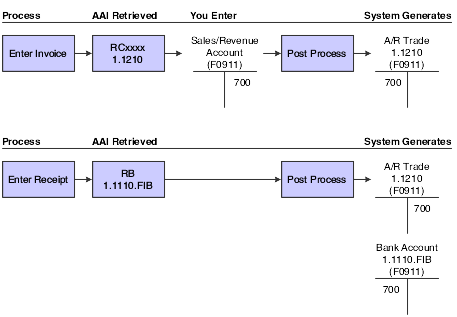Understanding Accounts Receivable AAIs
Each time that you enter a transaction for which the system must create journal entries, the system must locate the appropriate account numbers. It does this by reviewing the AAI table for codes that correspond to the transaction. For example, AAIs direct the system to the accounts receivable trade account to debit when you post invoices or the correct bank account to debit when you post receipts.
The name of an AAI item, such as RC, is hard-coded. AAI items for Accounts Receivable always start with the letter R. For example, RC is the AAI item for the receivables class (trade) account, and RB is for the receivables bank account. Each AAI item has account codes consisting of a business unit, an object, and optionally, a subsidiary, which are mapped to the chart of accounts.
If you do not define a business unit in the AAI items RA, RC, RKD, RFC, and RFD, the system assigns the security business unit from the invoice. The security business unit, which is assigned to the customer Address Book record, is used as a default business unit when you enter invoices. If you do not assign a business unit to the AAI, the business unit from the invoice is concatenated with the object account of the AAI and is used as the account number. This process provides additional flexibility and enables specific accounts to be tracked by the business unit.
This diagram illustrates how the JD Edwards EnterpriseOne Accounts Receivable system uses AAIs for instructions during invoice and receipt processing:

Each time that you enter a transaction, the system locates the:
Company number
G/L offset
The system reviews the appropriate AAI table to locate an account number that has been set up for the combination of company and AAI item. If an account number exists for the combination, the system uses that account. If no account number exists, the system uses the account set up for company 00000.